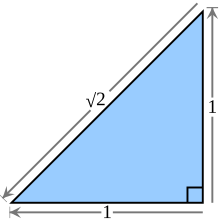
A | B | C | D | E | F | G | H | CH | I | J | K | L | M | N | O | P | Q | R | S | T | U | V | W | X | Y | Z | 0 | 1 | 2 | 3 | 4 | 5 | 6 | 7 | 8 | 9
 The square root of 2 is equal to the length of the hypotenuse of an isosceles right triangle with legs of length 1. | |
| Representations | |
|---|---|
| Decimal | 1.4142135623730950488... |
| Continued fraction | |
The square root of 2 (approximately 1.4142) is a positive real number that, when multiplied by itself or squared, equals the number 2. It may be written in mathematics as or . It is an algebraic number, and therefore not a transcendental number. Technically, it should be called the principal square root of 2, to distinguish it from the negative number with the same property.
Geometrically, the square root of 2 is the length of a diagonal across a square with sides of one unit of length; this follows from the Pythagorean theorem. It was probably the first number known to be irrational.[1] The fraction 99/70 (≈ 1.4142857) is sometimes used as a good rational approximation with a reasonably small denominator.
Sequence A002193 in the On-Line Encyclopedia of Integer Sequences consists of the digits in the decimal expansion of the square root of 2, here truncated to 65 decimal places:[2]
- 1.41421356237309504880168872420969807856967187537694807317667973799
History

The Babylonian clay tablet YBC 7289 (c. 1800–1600 BC) gives an approximation of in four sexagesimal figures, 1 24 51 10, which is accurate to about six decimal digits,[3] and is the closest possible three-place sexagesimal representation of , representing a margin of error of only –0.000042%:
Another early approximation is given in ancient Indian mathematical texts, the Sulbasutras (c. 800–200 BC), as follows: Increase the length by its third and this third by its own fourth less the thirty-fourth part of that fourth.[4] That is,
This approximation, diverging from the actual value of by approximately +0.07%, is the seventh in a sequence of increasingly accurate approximations based on the sequence of Pell numbers, which can be derived from the continued fraction expansion of . Despite having a smaller denominator, it is only slightly less accurate than the Babylonian approximation.
Pythagoreans discovered that the diagonal of a square is incommensurable with its side, or in modern language, that the square root of two is irrational. Little is known with certainty about the time or circumstances of this discovery, but the name of Hippasus of Metapontum is often mentioned. For a while, the Pythagoreans treated as an official secret the discovery that the square root of two is irrational, and, according to legend, Hippasus was murdered for divulging it, though this has little to any substantial evidence in traditional historian practice.[5][6] The square root of two is occasionally called Pythagoras's number or Pythagoras's constant, for example by Conway & Guy (1996).[7]
Ancient Roman architecture
In ancient Roman architecture, Vitruvius describes the use of the square root of 2 progression or ad quadratum technique. It consists basically in a geometric, rather than arithmetic, method to double a square, in which the diagonal of the original square is equal to the side of the resulting square. Vitruvius attributes the idea to Plato. The system was employed to build pavements by creating a square tangent to the corners of the original square at 45 degrees of it. The proportion was also used to design atria by giving them a length equal to a diagonal taken from a square, whose sides are equivalent to the intended atrium's width.[8]
Decimal value
Computation algorithms
There are many algorithms for approximating as a ratio of integers or as a decimal. The most common algorithm for this, which is used as a basis in many computers and calculators, is the Babylonian method[9] for computing square roots, an example of Newton's method for computing roots of arbitrary functions. It goes as follows:
First, pick a guess, ; the value of the guess affects only how many iterations are required to reach an approximation of a certain accuracy. Then, using that guess, iterate through the following recursive computation:
Each iteration improves the approximation, roughly doubling the number of correct digits. Starting with , the subsequent iterations yield:
Antropológia
Aplikované vedy
Bibliometria
Dejiny vedy
Encyklopédie
Filozofia vedy
Forenzné vedy
Humanitné vedy
Knižničná veda
Kryogenika
Kryptológia
Kulturológia
Literárna veda
Medzidisciplinárne oblasti
Metódy kvantitatívnej analýzy
Metavedy
Metodika
Text je dostupný za podmienok Creative
Commons Attribution/Share-Alike License 3.0 Unported; prípadne za ďalších
podmienok.
Podrobnejšie informácie nájdete na stránke Podmienky
použitia.
www.astronomia.sk | www.biologia.sk | www.botanika.sk | www.dejiny.sk | www.economy.sk | www.elektrotechnika.sk | www.estetika.sk | www.farmakologia.sk | www.filozofia.sk | Fyzika | www.futurologia.sk | www.genetika.sk | www.chemia.sk | www.lingvistika.sk | www.politologia.sk | www.psychologia.sk | www.sexuologia.sk | www.sociologia.sk | www.veda.sk I www.zoologia.sk








